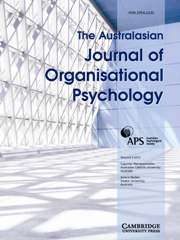Article contents
Effort-Reward Imbalance and Intention to Retire Early in Australian Healthcare Workers
Published online by Cambridge University Press: 26 May 2017
Abstract
Objectives – Retaining older workers in the Australian Healthcare System in rural areas is critical in preventing an imminent workforce crisis. Traditionally, healthcare workers have retired earlier than other groups. Using an internationally recognised model of job stress, the aim of this study was to examine the influence of Effort-Reward Imbalance (ERI) in predicting psychological strain and intention to retire in older Australian healthcare workers. Method – Utilising a cross-sectional design, data was obtained from 295 women and men aged over 55 years, working as professional healthcare workers in a rural Australian setting. ERI was measured using the 23-item scale developed by Siegrist (Siegrist, 2002); psychological strain was measured using the 12-item version of the General Health Questionnaire (GHQ) and a question on retirement intentions was developed. Results – The results confirm that those employees who experience high ERI and higher levels of overcommitment (OVC) experience psychological strain. Support for the three-way interaction was mixed: at low levels of OVC, higher levels of effort and increasing reward decreased strain, yet at high levels of OVC, increasing reward increased strain. This study could not confirm an association between intention to retire early and effort, reward, OVC or strain.
- Type
- Articles
- Information
- Copyright
- Copyright © Australian Psychological Society Ltd 2017
References
- 5
- Cited by




